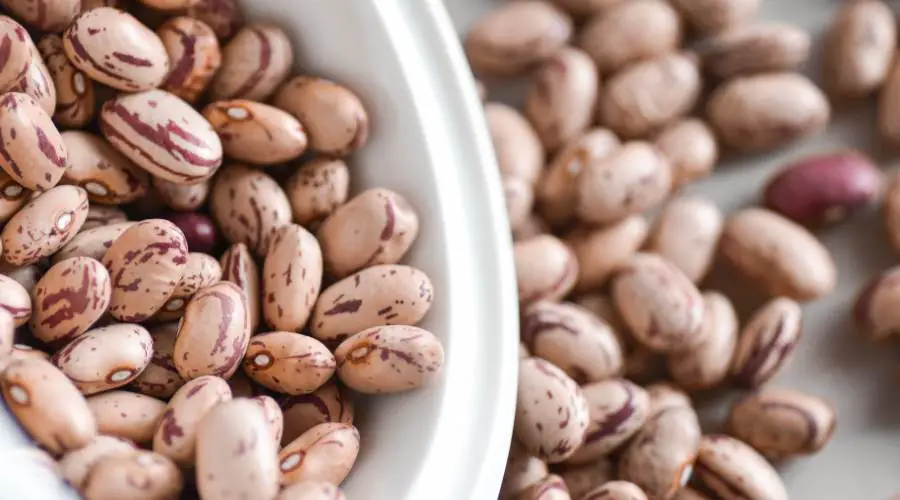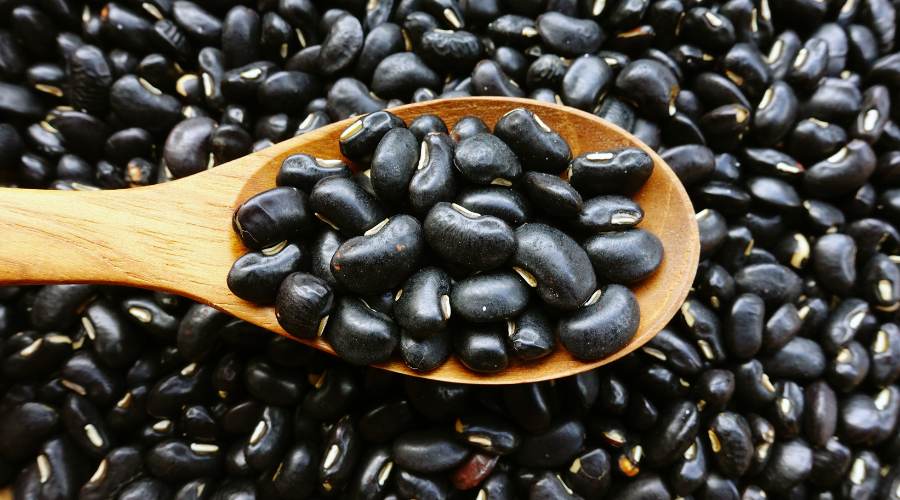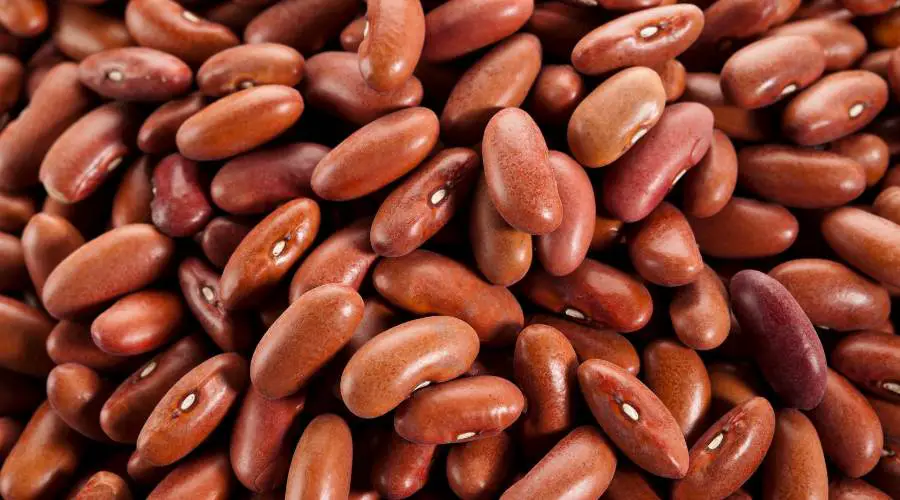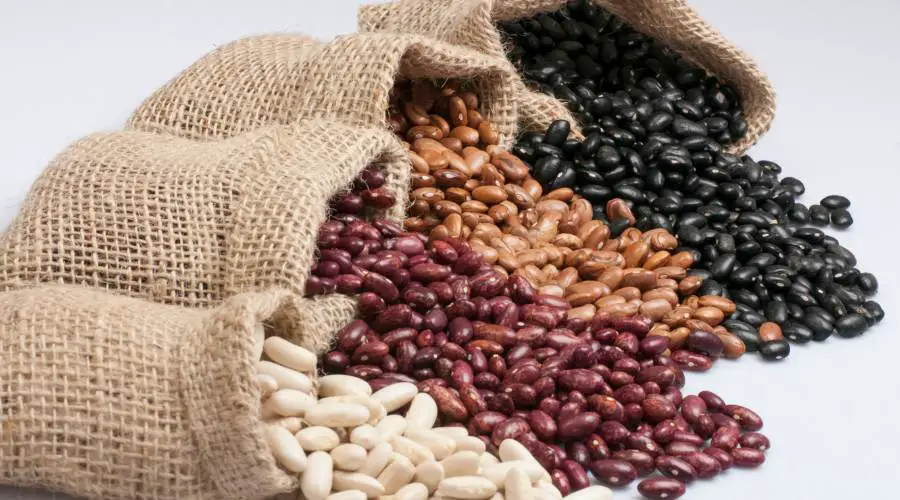I have found that learning about the Shelf life of Beans is important because they are a staple food for many households, and for good reason. They’re a great source of protein, fiber, and vitamins, making them an important part of a healthy diet. Also, they store well long-term making them a great option to have in your home food storage (see our food storage calculator).
However, when it comes to storing beans, you need to know how long they’ll last and how to keep them fresh. In this article, we’ll take a look at the shelf life of different types of beans, including dry pinto, black, kidney, and more.
How Long Can you Store Dry Beans?
| Bean Type | Shelf Life (months) | Edible w/ Loss of Nutritional Value (years) | Best Storage Conditions |
|---|---|---|---|
| Dried Pinto Beans | 18-24 | 3+ | Cool, Dry, and Oxygen Free |
| Black Beans | 18-24 | 3+ | Cool, Dry, and Oxygen Free |
| Kidney Beans | 18-24 | 3+ | Cool, Dry, and Oxygen Free |
| Garbanzo Beans (Chickpeas) | 18-24 | 3+ | Cool, Dry, and Oxygen Free |
| Navy Beans | 18-24 | 3+ | Cool, Dry, and Oxygen Free |
| Lima Beans | 6-18 | 2+ | Cool, Dry, and Oxygen Free |
| Lentils | 18-24 | 3+ | Cool, Dry, and Oxygen Free |
| Black-Eyed Peas | 18-24 | 3+ | Cool, Dry, and Oxygen Free |
| Adzuki Beans | 18-24 | 3+ | Cool, Dry, and Oxygen Free |
| Great Northern Beans | 18-24 | 3+ | Cool, Dry, and Oxygen Free |
Introduction to the Shelf Life of Dry Beans
Most dry beans have a shelf life of 1 to 2 years (USDA) and maintain their nutrients. However, being nonperishable, they can remain edible for 3 years or even much longer if stored properly. The shelf life of beans can be extended by maintaining optimal storage conditions, including keeping them in airtight containers in a cool, dry, and oxygen-free environment (see how to use oxygen absorbers).
See in detail how to store dry beans long term so that you can enjoy them years later.
It’s important to note that while beans can last for a long time, they start to lose their nutritional value after a certain period, even if they are still safe to eat. This is why it’s recommended to consume beans within 1-2 years of purchasing them to ensure that they provide the maximum nutritional value. So, when considering the shelf life of beans, it’s not only about how long they last but also about their quality and nutritional value over time.
Overall, the shelf life of beans will depend on several factors, including the type of bean, the storage method, and the temperature. In general, dried beans have a longer shelf life than fresh beans, but there are a few things you can do to extend their shelf life. In this article, we’ll take a closer look at the shelf life of different types of beans, including dried pinto, black, and more.
Pinto Beans: The Most Popular Dry Bean
Pinto beans are one of the most popular and widely used dry beans in the world. They have a creamy texture and mild, earthy flavor that makes them a staple ingredient in many dishes, from chili to burritos. But what about the shelf life of pinto beans?
Shelf Life of Pinto Beans
Pinto beans have a shelf life of 1-2 years, making them a great pantry staple for those looking to stock up on nonperishable foods. This shelf life can be extended to 3+ years if stored correctly in cool, dry, and oxygen-free conditions. However, it is important to note that even though they can last for several years, pinto beans will start to lose some of their nutritional value after that.

One of the benefits of pinto beans is their versatility. They can be used in a variety of dishes, from salads to soups, and can also be mashed or pureed to make dips and spreads. They are also a great source of protein, fiber, and iron, making them a nutritious addition to any meal.
Storing Pinto Beans
When storing pinto beans, it is important to keep them in a cool, dry place, such as a pantry or cupboard, away from heat and moisture. They should also be stored in an airtight container to prevent exposure to oxygen, which can cause them to spoil faster.
It is also important to inspect pinto beans before using them to ensure that they are still fresh. If they have a musty or moldy odor, it is best to discard them as they have likely gone bad. Additionally, if the beans have started to sprout, they should also be discarded as this is a sign of spoilage.
Also, see complete guides on how to store these common types of food storage items:
Black Beans
Black beans are a staple in many kitchens around the world. They are versatile and can be used in a variety of dishes such as soups, stews, salads, and rice dishes. They are also highly nutritious and a great source of protein, fiber, and essential minerals. But just how long do black beans last and what is the best way to store them for maximum shelf life and freshness? Let’s take a closer look.
Shelf Life and Storage
The shelf life of black beans is 1-2 years when stored properly. It is important to keep black beans in a cool, dry, and oxygen-free environment to extend their shelf life. Keeping them in an airtight container will also help to preserve their freshness. See more about how to store beans long-term.
It is important to note that while black beans may still be edible after 3 years, they will start to lose their nutritional value. Cooking and consuming dried black beans that are past their prime may result in a decrease in their beneficial nutrients and may even lead to digestive issues.

Cooking and Preparing Black Beans
Black beans are easy to cook and prepare, making them a great option for busy weeknights or meal prep. They can be cooked on the stovetop or in a slow cooker, and are also suitable for sprouting. Sprouting black beans increases their nutritional value and can make them easier to digest.
Kidney Beans
Kidney beans are one of the most versatile and nutritious bean, commonly used in a wide range of dishes such as chili, salads, and stews. The shelf life of kidney beans, when stored properly, ranges from 1 to 2 years, and they remain edible with a loss of nutritional value for 3 years or longer. Let’s explore the shelf life and best storage conditions for kidney beans.
The Benefits of Kidney Beans
Kidney beans are a great source of protein, fiber, and complex carbohydrates. They are also low in fat, making them an excellent addition to a healthy diet. In addition to their nutritional benefits, kidney beans are easy to cook, and their creamy texture and mild flavor make them a versatile ingredient in many recipes.
Shelf Life of Kidney Beans
The shelf life of kidney beans depends on the storage conditions and can range from 1 to 2 years. Proper storage, such as keeping the beans in an airtight container in a cool, dry place, can help extend their shelf life. Kidney beans should be stored in an airtight container to prevent moisture from entering and should be kept in a cool, dry place to prevent spoilage.
Edible Life of Kidney Beans
Although the shelf life of kidney beans is only 1 to 2 years, they can remain edible for 3 years or longer if stored properly. After this period, the beans may start to lose their nutritional value, but they can still be consumed safely. To ensure that your kidney beans remain edible and nutritious, it is important to store them in an airtight container in a cool, dry place.

Best Storage Conditions for Kidney Beans
The best storage conditions for kidney beans are cool, dry, and oxygen-free. Kidney beans should be stored in an airtight container to prevent moisture from entering and to protect them from light, which can cause them to spoil. It is also important to store the beans in a cool, dry place to prevent spoilage and to extend their shelf life.
We like to use food-grade buckets and even mylar bags with oxygen absorbers to store dry beans.
Best Food-Grade Bucket
Food-grade,
BPA-free,
Gamma screw-on lids are included making it easy to access
Also, consider these mylar bags (see on Amazon) oxygen absorbers are included. We have used both of these products and have found them to work well together.
6 Other Common Beans
Garbanzo Beans (Chickpeas)
Garbanzo beans, also known as chickpeas, are a versatile and popular legume used in many dishes around the world. They have a mild, nutty flavor and are commonly found in Middle Eastern and Mediterranean cuisines. Garbanzo beans are a good source of protein, fiber, and other nutrients, making them a nutritious addition to any meal.
When stored properly, garbanzo beans have a shelf life of 2 to 3 years. However, like other dry beans, their edible life can be extended beyond this time frame if stored in ideal conditions. To ensure the best quality and taste, it’s recommended to consume garbanzo beans within 1 to 2 years after purchase.
Navy Beans
Navy beans, also known as Boston beans or Yankee beans, are small, white beans that are commonly used in baked bean dishes. They have a mild flavor and creamy texture, making them a popular ingredient in soups and stews as well. Navy beans are a good source of protein, fiber, and other essential nutrients.
Navy beans have a similar shelf life to other dry beans, lasting for 1 to 2 years when stored in a cool, dry, and oxygen-free environment. However, they can remain edible for up to 3 years or longer if stored correctly. As with other dry beans, the nutritional value of navy beans may decrease over time, so it’s recommended to consume them within 2 years of purchase for optimal quality and nutrition.
Lima Beans
Lima beans, also known as butter beans, are a large, creamy white bean with a delicate flavor and smooth texture. They are commonly used in soups and stews and are a good source of protein, fiber, and other nutrients.
When stored properly, Lima beans have a shelf life of about a year and a half. However, like other dry beans, their edible life can be extended beyond this time frame if stored in ideal conditions. To ensure the best quality and taste, it’s recommended to consume Lima beans within 1 to 2 years after purchase.
Black-Eyed Peas
Black-eyed peas are a small, beige-colored legume with a black spot at the center. They have a mild flavor and are commonly used in Southern cuisine, especially in dishes like Hoppin’ John and black-eyed pea soup. Black-eyed peas are a good source of protein, fiber, and other essential nutrients.
When stored properly, black-eyed peas have a shelf life of 1 to 2 years like most other commonly stored dry beans. Edible life can be extended beyond 3 years but will begin losing nutritional value over time.
Adzuki Beans
Adzuki beans are a small, reddish-brown bean commonly used in Asian cuisine. They have a slightly sweet and nutty flavor and are often used in sweet dishes like red bean paste and rice cakes. Adzuki beans are a good source of protein, fiber, and other essential nutrients.
When stored properly, Adzuki beans have a shelf life and edible life that is comparable to other common dry beans.
How to Tell if Beans Have Gone Bad
Even with proper storage, beans can go bad over time. Here are some signs that your beans have gone bad:
- Bad odor: If your beans have an off or sour smell, it’s a sign that they’ve gone bad and should be thrown out.
- Mold: If you see mold on your beans, it’s best to throw them out as they are no longer safe to eat.
- Changes in texture or flavor: If your beans have become hard or have a different flavor than they normally do, it’s a sign that they’ve gone bad and should be discarded.

FAQs about Shelf Life of Beans
Here are some frequently asked questions about the shelf life of beans:
How do you store beans for 10 years?
According to Michigan State University Extension (MSU), “If beans are stored in food grade packaging, sealed buckets, reduced oxygen packaging or heavier plastic (Mylar) bags then they can be kept for ten years or more.”
What Bean has the longest shelf life?
Here are 20 of the most common dry beans that have a long shelf life:
- Adzuki Beans
- Black Beans
- Black Eyed Peas
- Cannellini Beans
- Cranberry Beans
- Fava Beans
- Garbanzo Beans (Chickpeas)
- Great Northern Beans
- Kidney Beans
- Lentils
- Lima Beans
- Mung Beans
- Navy Beans
- Pinto Beans
- Red Beans
- Soybeans
- Split Peas
- Urad Dal
- Yellow Eye Beans
- White Beans
Can I freeze beans?
Yes, you can freeze beans. Just make sure to store them in an airtight container or freezer-safe bag, and they’ll last for up to six months in the freezer.
Can I store beans in the refrigerator?
Yes, you can store beans in the refrigerator, but it’s important to make sure they’re stored in an airtight container to keep out moisture and air.
In conclusion, the shelf life of dry beans can vary depending on the type of bean and storage conditions. While most dry beans have a shelf life of 1 to 2 years according to the USDA, they can remain edible for 3 years or longer if stored correctly but may start to lose nutritional value after that. It is important to store dry beans in a cool, dry, and oxygen-free environment to help extend their shelf life and maintain their quality.
When purchasing dry beans, it is important to check the packaging for any signs of damage, such as tears or holes. Beans that are damaged or have been exposed to moisture may have a shorter shelf life and may not be safe to eat.
By following the proper storage techniques and checking for signs of damage, you can extend the shelf life of your dry beans and enjoy their delicious flavor and nutritional benefits for years to come. So next time you stock up on Pinto, Black, Kidney, Garbanzo, Navy, Lima, Lentils, Black-Eyed Peas, Adzuki, or Great Northern Beans, be sure to store them properly to maximize their shelf life and quality.



